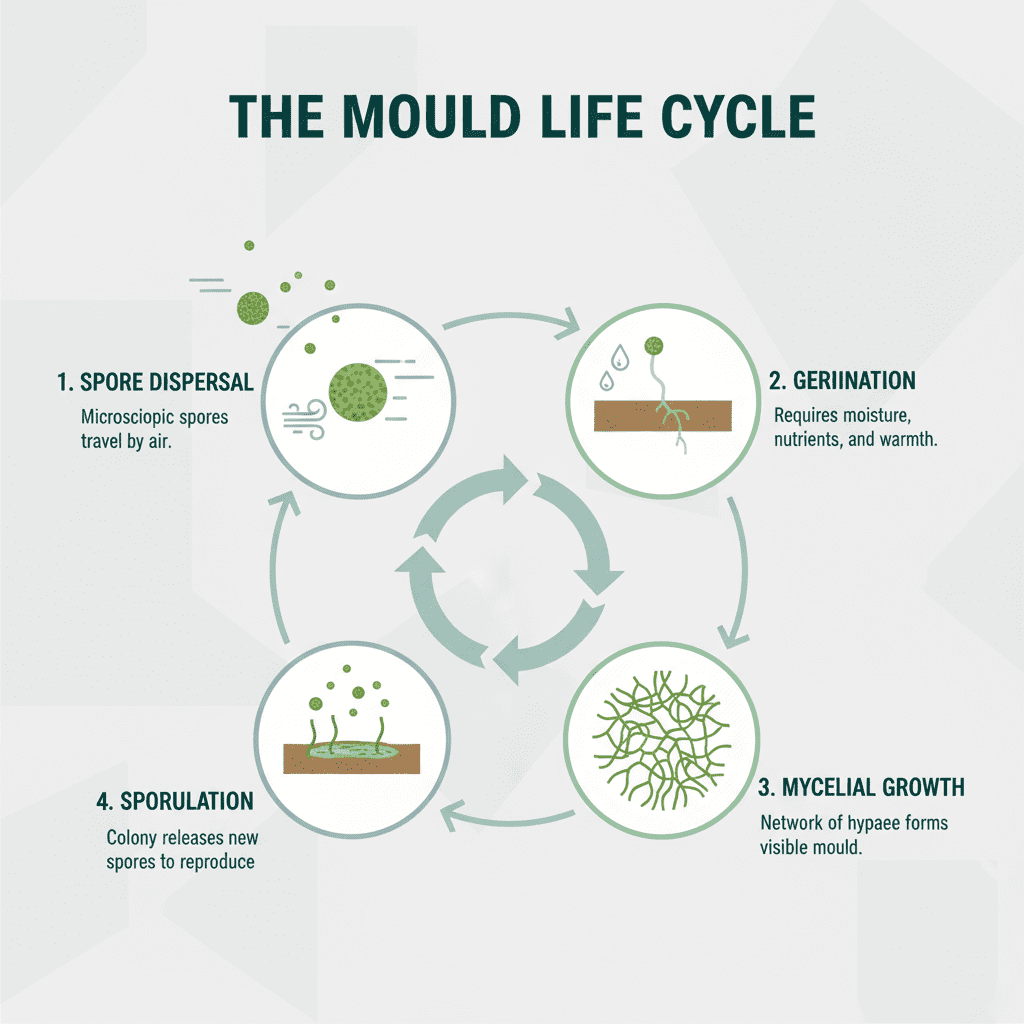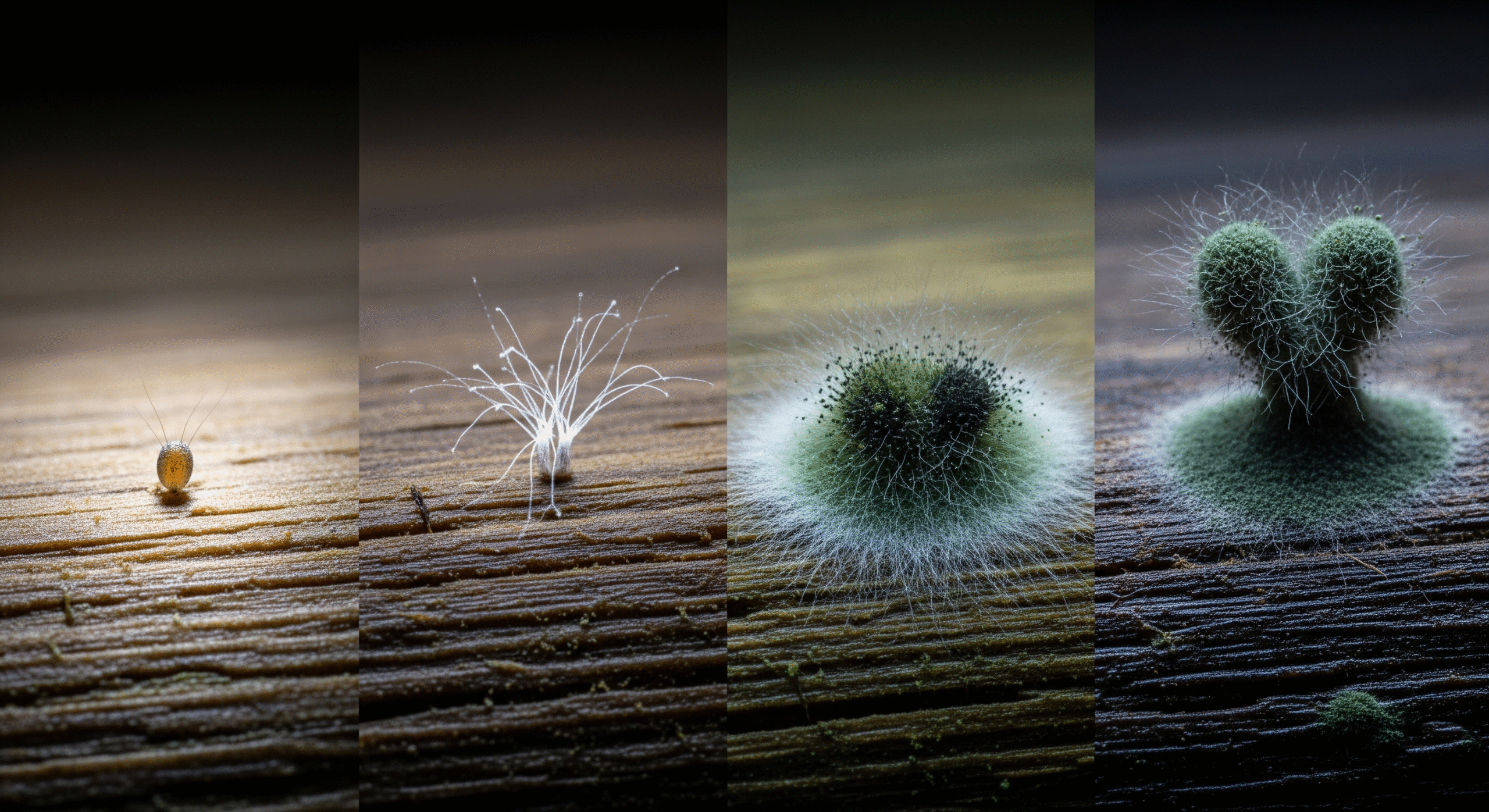Mould is a pervasive issue in residential and commercial buildings worldwide. While often identified simply as a visual blemish or a source of musty odours, mould is a complex organism with a distinct biological life cycle. A comprehensive understanding of this cycle is fundamental to implementing effective, long-term remediation and prevention strategies.
This article provides a professional overview of the four primary stages of mould development, from a single microscopic spore to a large, visible colony.
Stage 1: Spore Dispersal and Dormancy
The mould life cycle begins with the spore. Spores are microscopic, seed-like reproductive units that are ubiquitous in both outdoor and indoor environments. Due to their minute size and low mass, they are easily dispersed by air currents, HVAC systems, and on clothing or pets, allowing them to travel vast distances and readily enter buildings.
In the absence of suitable conditions, mould spores exist in a dormant state. They are remarkably resilient, capable of surviving for extended periods in dry and unfavourable environments. This dormancy allows them to wait until the necessary elements for growth become available.
Stage 2: Germination
Germination marks the transition from a dormant spore to an active, growing organism. This stage is critically dependent on a specific set of environmental triggers. For germination to occur, a spore must land on a substrate where the following conditions are met:
- Moisture: This is the most critical factor. Mould requires a certain level of water activity (aw) on a surface to germinate. This moisture can be supplied by a water leak, high relative humidity (above 60-70%), condensation, or a flood event.
- Nutrient Substrate: Mould functions as a decomposer, metabolising organic materials for energy. Common indoor food sources include the cellulose paper on drywall, wood, dust, wallpaper adhesives, and natural fibre carpets.
- Temperature: Most indoor mould species thrive in temperatures between 15°C and 27°C (60°F and 80°F), a range that aligns closely with typical human habitation.
When these conditions are present, the spore activates and extends a small, root-like filament known as a germ tube, initiating the colonisation process.
Stage 3: Mycelial Growth
Following germination, the organism enters a phase of vegetative growth. The initial germ tube elongates and branches extensively, forming a network of thread-like filaments called hyphae. These hyphae penetrate the substrate, secreting digestive enzymes to break down the organic material into absorbable nutrients.
As the hyphae continue to grow and intertwine, they form a large, interconnected mass known as a mycelium. This mycelium is the visible structure that we recognise as a mould colony. The appearance of this colony—its colour, texture, and shape—is dependent on the specific mould species (e.g., the dark, slimy appearance of Stachybotrys chartarum versus the grey-green, powdery texture of Aspergillus). By the time a mycelium is visible, the colony is well-established and significant material degradation may have already occurred.
Stage 4: Sporulation (Reproduction)
Once a mycelium reaches maturity, its primary objective shifts to reproduction to ensure the continuation of its species. This process is known as sporulation. The mycelium develops specialised reproductive structures (such as sporangiophores or conidiophores) which grow upwards from the surface of the substrate.
These structures are responsible for producing vast quantities of new, genetically identical spores. A single, small colony can generate millions of spores, which are then released into the ambient air. Physical disturbances, air movement, or even the act of wiping the mould can trigger a massive release event. These new spores are then dispersed throughout the environment, ready to settle on new surfaces and, if conditions are right, initiate the life cycle once again.

Implications for Mould Management
Understanding this four-stage life cycle reveals why simply cleaning visible mould is often insufficient. Effective mould management requires interrupting the cycle at its most vulnerable point: germination.
By controlling moisture within the built environment—through repairing leaks, managing humidity, and ensuring adequate ventilation—property owners can prevent spores from ever activating. For established colonies, professional remediation must address not only the visible mycelium (Stage 3) but also the control of airborne spores (Stage 4) and, most importantly, the elimination of the moisture source that enabled the growth in the first place. A proactive approach based on a scientific understanding of the fungal life cycle is the most effective defence against mould proliferation.

